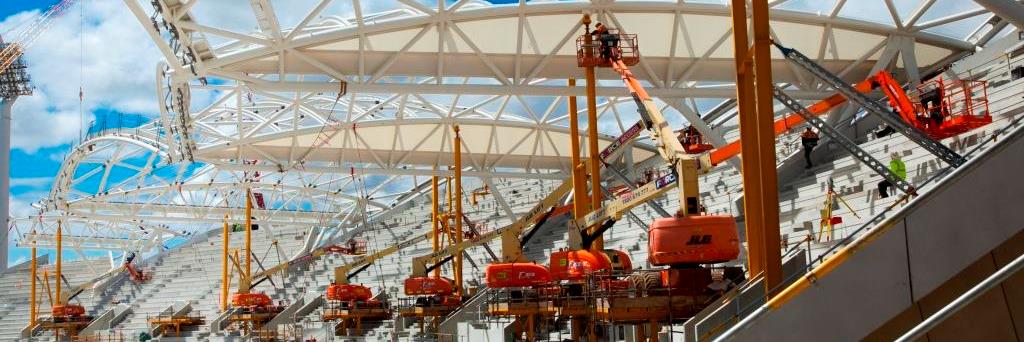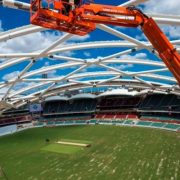Adelaide Oval
Australian’s all love a good sporting match; from Cricket to Rugby, AFL to NRL. The next time you are at a match cheering on your team, take a moment to look at the stadium you are sitting in and give a thought to those who were involved in the construction of this mega structure. This story is about the detail and sheer volume of equipment required to build one of these large entertainment facilities. The Adelaide Oval project involved multiple contractors working together for over 18 months to get this project finished in time for the 2013/2014 Cricket season.
The Challenge
When it comes to designing and building an entire entertainment facility such as the Adelaide Oval there are many challenges which need to be tackled and planned in detail to ensure project goals are met, on time, on budget and safely. A challenge faced early on in the project life was for contractors Samaras and Ferrari Engineering who partnered with Force when they required a working at height solution in order to erect the Eastern and Southern stand including the roof, by November 2013. The equipment chosen would need to work from where the seating had already been placed in the stand. This was so the workmen would be able to reach to secure the steel in place to construct what was to make up the roof. As there was no elevated work platform with large enough working height which could reach from the grounds of the stadium to the roof of the stadium, it was up to Force to work with Samaras and Ferrari Engineering to find a solution.
The Force Solution
It was decided by Samaras that the equipment used would be used from plinths, custom manufactured for this purpose, which were strategically placed coming out from the stadiums allocated seating area. This was the best solution to ensure that the men required to secure the roof in place could reach the destined height safely.

Planning
After initial meetings between Force and Samaras going through in detail what they required the equipment to do, including detail as to which machine had the right operating arcs and range of motion it was decided the best equipment fit for them would in fact be a Force, JLG 86’ Boom. This equipment would ensure the workmen could safely reach the working height required. The next process was to create a plan for how the boom lifts would safely be placed on each plinth which had been built specifically for them. It was decided that each machine could be craned into position, but in order to do this safely each machine was to have the counter weights removed, and re-attached once they were safely on their allocated plinth. For safety reasons Force also ensured that the drive function was disabled on every machine for the duration of the hire. Throughout the process there was continuous meetings to ensure Force had an overview at all times of how many machines would be required so that if needed Force could arrange for the machines to be moved from other branches across Australia for the project.
Carrying out the plan
Adelaide Oval has hosted both cricket and football at the highest level since Colonial times and its iconic, historic and cultural presence remains today. The idea behind the construction of the new Adelaide Oval was to bring the cricket and football together at this iconic location, mixing the very best of new world wide designs and stadium operations. Putting all these existing and new elements together, and carefully integrating the highly valued surrounding parklands into the composition, the Adelaide Oval will acquire a new found memorial identity – one that further enhances the way Adelaide is viewed without destroying the essential imagery of the city within the park. With all our Force gear ready to be delivered and months of planning carried out, it was time to put those plans into action as the project got underway! With a Force representative on site almost every day working alongside Samaras and Ferrari Engineering, there was a great relationship built to ensure the successful completion of this project. On an average day there were approximately 80 Force machines working on site, and at its peak there were over 120 pieces of equipment working together to meet project deadlines. With so many machines on site over a lengthy time period Force wanted to ensure that the chance of in field failures was reduced. Throughout the hire period on any given day up to two Force mechanics were on site carrying out scheduled servicing and were on call to attend to any breakdowns should they happen. The mechanics also liaised with our customers to carry out spot checks – once again to reduce the risk of a breakdown. The project was finished on schedule, and the first cricket match was played while the finishing touches were done to the Oval in November 2013. “Force was a pleasure to deal with on this project. They were professional and helpful across the planning and implementation stage, which enabled the project to run smoothly with the outcomes and deadlines met– a credit to all involved.” – Daniel Forgione, Samaras Download the PDF of the Case Study



